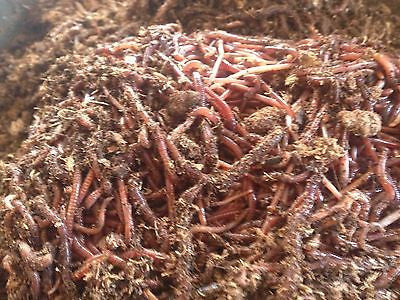Red Wiggler Worms - All-natural Service for Environmentally Friendly Composting
Wiki Article
Red Wiggler Worms Demystified: Opening the Secrets of Vermiculture for Greener Living and Nutrient-Rich Soil
In the world of lasting methods for enriching soil top quality and promoting eco-conscious living, red wiggler worms play an essential yet frequently overlooked function. Red Wiggler Worms. Understanding the details of caring for these worms, maximizing their atmosphere, and utilizing their castings can lead to a greener way of life and healthier soil for plants to grow.The Function of Red Wiggler Worms
Red Wiggler worms play an essential duty in composting systems by effectively breaking down organic issue into nutrient-rich spreadings. These starved eaters eat a range of organic products, such as cooking area scraps, lawn waste, and paper items. As they feed, the worms' digestive system processes damage down the natural matter into a penalty, dark, and nutrient-dense product called worm castings or vermicompost.The castings generated by Red Wiggler worms are highly advantageous for soil health and plant development. They are abundant in crucial nutrients like potassium, nitrogen, and phosphorus, which are vital for supporting healthy plant growth. In addition, worm spreadings include beneficial microorganisms and enzymes that help boost soil framework, boost water retention, and enhance nutrient uptake by plants.
Benefits of Vermicomposting

Furthermore, vermicompost, the nutrient-rich end product of vermicomposting, functions as an outstanding organic plant food and dirt conditioner. It boosts dirt structure, improves soil aeration, and boosts dirt wetness retention. These properties contribute to healthier plants with more powerful root systems and far better resistance to bugs and conditions. Vermicompost additionally improves the dirt with necessary nutrients like potassium, phosphorus, and nitrogen, promoting plant growth and general soil fertility.
Additionally, vermicomposting supports sustainable horticulture practices by providing a all-natural and chemical-free alternative to artificial plant foods. Red Wiggler Worms. This eco friendly technique not just improves the soil however also helps in reducing dependence on dangerous chemicals, advertising a greener and extra sustainable way of horticulture
Setting Up a Worm Container
When developing a worm container for vermicomposting, appropriate configuration is vital to make certain the success of the composting process. The first action in establishing up a worm bin is picking a suitable container.After adding the bedding, introduce the red wiggler worms to the bin. The worms ought to then be provided with food scraps such as fruit and veggie peels, coffee premises, and eggshells.
Regularly check the dampness levels and temperature level in the worm container to ensure optimum conditions for the worms. With proper arrangement and upkeep, the worm container will successfully transform organic waste into nutrient-rich garden compost for your plants and yard.
Gathering Worm Castings
To successfully collect nutrient-rich worm spreadings from your vermicomposting system, a methodical harvesting technique is vital. When it comes time to collect the worm castings, there are a view couple of vital steps to follow to ensure a successful process. Quit including fresh food scraps to one side of the worm bin for a couple of weeks prior to gathering. This urges the worms to migrate to the side with fresh bed linens and food, making it much easier to scoop out the castings from the opposite.
Troubleshooting Common Issues
Identifying and attending to common challenges that might arise during the vermicomposting process is essential for maintaining a healthy and efficient worm bin. One typical issue that vermicomposters experience is overfeeding. Adding excess food scraps can lead to a buildup of moisture and acidity in the worm container, potentially harming the worms. To stop this, feed the worms in small amounts, guaranteeing that the food scraps are effectively broken down prior to including a lot more. One more problem is undesirable odors rising from the worm container. Foul smells indicate anaerobic problems, commonly triggered by overwatering or insufficient air flow. To remedy this, adjust the dampness levels by adding dry bedding materials like shredded paper or cardboard and rise oygenation by turning the bedding regularly.
In addition, if the worm populace is declining or the worms show up harmful, maybe as a here are the findings result of environmental stressors such as severe temperature levels or pH levels. Monitoring these factors and making necessary adjustments is vital for the health of the worms. By fixing these usual concerns promptly, vermicomposters can guarantee a effective and smooth vermicomposting process while preserving a growing worm population.

Conclusion
Finally, red wiggler worms play an important function in vermiculture by breaking down organic issue check into nutrient-rich soil. The benefits of vermiculture consist of greener living and improved dirt top quality. Establishing a worm bin is vital for effective vermiculture, and harvesting worm spreadings provides important compost for horticulture. By comprehending and repairing usual problems, individuals can open the tricks of vermiculture for sustainable living and much healthier soil.As they feed, the worms' digestion processes damage down the natural issue right into a penalty, dark, and nutrient-dense product recognized as worm spreadings or vermicompost.
The castings generated by Red Wiggler worms are very useful for dirt health and wellness and plant development. Including excess food scraps can lead to a build-up of wetness and level of acidity in the worm bin, possibly damaging the worms.Furthermore, if the worm population is decreasing or the worms appear undesirable, it might be due to environmental stress factors such as extreme temperature levels or pH degrees. Setting up a worm container is crucial for successful vermiculture, and harvesting worm castings offers beneficial garden compost for gardening.
Report this wiki page